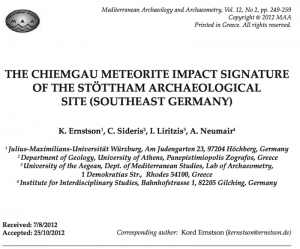THE CHIEMGAU METEORITE IMPACT SIGNATURE OF THE STÖTTHAM ARCHAEOLOGICAL SITE (SOUTHEAST GERMANY)
ABSTRACT. – Archaeological excavation at Chieming-Stöttham in the Chiemgau region of Southeast Germany revealed a diamictic (breccia) layer sandwiched between a Neolithic and a Roman occupation layer. This exotic layer bears evidence of its deposition in a catastrophic event that is attributed to the Chiemgau meteorite impact. In the extended crater strewn field produced by the impact, geological excavations have uncovered comparable horizons with an anomalous geological inventory intermixed with archaeological material. Evidences of extreme destruction, temperatures and pressures including impact shock effects suggest that the current views on its being an undisturbed colluvial depositional sequence as postulated by archaeologists and pedologists/geomorphologists is untenable.



































